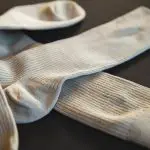If you've ever heard the saying 'like water off a duck's back,' you understand the value of water-resistant fabrics. When it comes to selecting the right materials for your outdoor gear or everyday clothing, it's essential to know which fabrics offer the best protection against moisture. Understanding the characteristics of natural, synthetic, performance, common, specialized, innovative, durable, and sustainable water-resistant fabrics can empower you to make informed choices.
From classic options like waxed cotton to cutting-edge materials like Gore-Tex, the world of water-resistant fabrics is vast and diverse. By exploring the properties of different fabrics, you can find the perfect balance of water resistance, breathability, and durability for your specific needs.
Key Takeaways
- Natural water-resistant fabrics, such as wool and certain types of cotton, offer an eco-friendly and sustainable alternative.
- Synthetic water-resistant fabrics, treated with waterproof coatings and breathable membranes, provide excellent water resistance.
- Performance water-resistant fabrics are designed for intense physical activities, repelling water while allowing moisture to escape.
- Specialized and innovative water-resistant fabrics, with advanced textile technology and waterproofing treatments, offer superior protection against the elements.
Natural Water-Resistant Fabrics
You can find natural water-resistant fabrics in materials like wool or certain types of cotton. These fabrics are often treated with plant-based waterproofing or natural fiber coatings to enhance their ability to repel water. Plant-based waterproofing involves using natural substances such as beeswax, plant resins, or oils to create a protective barrier on the fabric. This method has been used for centuries and is known for its effectiveness in making fabrics water-resistant.
Natural fiber coatings, on the other hand, involve applying a layer of natural substances to the fabric to improve its water-resistant properties. For example, lanolin, a natural wax derived from sheep's wool, can be used to coat wool fibers, making them naturally water-resistant. Similarly, certain types of cotton can be coated with natural substances to achieve water-resistant qualities without compromising the breathability and comfort of the fabric.
These methods provide an eco-friendly and sustainable alternative to synthetic waterproofing treatments, catering to those who prioritize natural and environmentally conscious solutions. When seeking natural water-resistant fabrics, look for these plant-based waterproofing and natural fiber coatings to ensure both functionality and environmental friendliness.
Synthetic Water-Resistant Fabrics
When selecting synthetic water-resistant fabrics, consider how they perform in various weather conditions and how they hold up over time. Synthetic fabrics can offer excellent water resistance, making them a popular choice for outdoor and sports apparel. Here are some key factors to keep in mind when evaluating synthetic water-resistant fabrics:
- Breathable membranes:
- Look for fabrics with breathable membranes that allow moisture to escape while keeping water out. This feature is essential for maintaining comfort during physical activities or in warmer climates.
- Waterproof coatings:
- Many synthetic water-resistant fabrics are treated with waterproof coatings to enhance their performance. These coatings provide an extra layer of protection against moisture, making the fabric more durable and reliable in wet conditions.
When choosing synthetic water-resistant fabrics, prioritize those with breathable membranes and effective waterproof coatings to ensure optimal performance and comfort. Whether you're hiking, skiing, or simply braving a rainy day, these fabrics can help you stay dry and comfortable, no matter the weather.
Performance Water-Resistant Fabrics
Consider advanced performance water-resistant fabrics for enhanced protection and durability in demanding outdoor conditions. When it comes to high performance rainwear textiles, look for materials that provide exceptional water resistance while allowing moisture to escape. These breathable waterproof materials are designed to keep you dry and comfortable, even during intense physical activities in wet weather.
Leading brands utilize innovative technologies to create high performance rainwear textiles that offer superior protection against the elements. These fabrics are engineered to repel water while maintaining breathability, ensuring that you stay dry from both rain and sweat. Whether you're hiking through heavy rain or enduring a downpour during a cycling expedition, these performance water-resistant fabrics are designed to keep you shielded from moisture.
When selecting performance water-resistant fabrics, prioritize those that offer long-lasting durability and reliable protection. Look for materials that are specifically designed for outdoor activities, as they're often constructed to withstand rugged conditions. With the right high performance rainwear textiles, you can confidently tackle any outdoor adventure without worrying about getting soaked.
Common Water-Resistant Fabrics
To identify common water-resistant fabrics, look for materials that repel water while maintaining breathability and durability. When considering waterproof vs water-resistant textiles, it's important to note that waterproof fabrics prevent water penetration entirely, while water-resistant fabrics repel water to some extent but may not withstand heavy or prolonged exposure.
The advantages of water-resistant clothing materials include protection against light rain or moisture, breathability to prevent overheating, and durability for long-lasting wear.
- Common Water-Resistant Fabrics
- Nylon: This synthetic fabric is lightweight, durable, and water-resistant, making it a popular choice for outdoor and athletic wear.
- Polyester: Known for its strength and resistance to wrinkling, polyester is often treated to improve its water-resistant properties, making it suitable for various outdoor activities.
When choosing water-resistant fabrics, consider the specific needs of your activities and the level of water resistance required. Understanding the differences between waterproof and water-resistant textiles will help you make informed decisions about the most suitable fabric for your needs.
Specialized Water-Resistant Fabrics
You can identify specialized water-resistant fabrics designed for particular activities or conditions that demand higher levels of water resistance and performance. Breathable waterproof materials are a key feature of these specialized fabrics, allowing for moisture vapor to escape while preventing water from penetrating the fabric. Advanced textile technology plays a crucial role in creating these high-performance fabrics, incorporating innovative techniques and materials to achieve exceptional water resistance without sacrificing comfort or breathability.
For instance, outdoor enthusiasts may benefit from specialized water-resistant fabrics that offer superior protection against heavy rain and wind while remaining breathable during strenuous activities such as hiking or mountaineering. Similarly, athletes and sports enthusiasts may require water-resistant fabrics that can withstand intense physical activity while keeping them dry and comfortable in various weather conditions. These specialized fabrics are engineered to provide the necessary level of water resistance without compromising on flexibility or breathability, making them ideal for demanding outdoor activities and sports.
Innovative Water-Resistant Fabrics
One key factor to consider when evaluating water-resistant fabrics is their ability to repel water while maintaining breathability and comfort. Innovative textile technologies and waterproofing treatments have led to the development of cutting-edge water-resistant fabrics that offer superior protection against the elements. Here are some of the innovative approaches that have revolutionized the water-resistant fabric industry:
- Nano Technology: Utilizing nanotechnology, fabrics are treated with microscopic particles that create a barrier against water, preventing it from penetrating the material while still allowing air to pass through. This results in fabrics that are highly water-resistant without compromising breathability.
- *Examples*: Some popular examples of nanotechnology in water-resistant fabrics include jackets and outdoor gear designed for extreme weather conditions.
- Membrane Technology: Fabrics engineered with advanced membrane technology feature microscopic pores that are smaller than water droplets, making them waterproof, yet large enough to allow sweat vapor to escape, ensuring comfort during physical activities.
- *Examples*: Membrane technology is often used in high-performance athletic apparel and footwear to provide water resistance without sacrificing breathability.
Durable Water-Resistant Fabrics
When selecting water-resistant fabrics, consider the durability of the material to ensure long-lasting protection against water. Durable outdoor textiles are essential for withstanding the elements and maintaining their water-resistant properties over time. Look for fabrics like Gore-Tex, eVent, or H2No, which are known for their exceptional durability and ability to repel water. These materials are often used in high-performance outdoor gear and are designed to provide long-term protection in harsh conditions.
If you're looking for sustainable rainwear options, consider fabrics made from recycled materials or those that are produced using eco-friendly manufacturing processes. Many outdoor brands are now prioritizing sustainability and offering durable, water-resistant fabrics that have minimal environmental impact. By choosing these options, you can enjoy the benefits of water-resistant clothing while minimizing your ecological footprint.
When investing in water-resistant fabrics, it's important to prioritize durability to ensure that your outdoor gear and clothing remain effective in repelling water for an extended period. By selecting durable outdoor textiles and sustainable rainwear options, you can enjoy reliable protection from the elements while making environmentally conscious choices.
Sustainable Water-Resistant Fabrics
Looking for water-resistant fabrics that are also sustainable? You're in luck! Eco-friendly water repellents, biodegradable waterproof materials, and sustainable outdoor gear are all part of the conversation.
These options provide you with the water-resistant properties you need while also aligning with your environmentally conscious values.
Eco-Friendly Water Repellents
If you're seeking eco-friendly water repellents, look for fabrics treated with sustainable alternatives. When it comes to eco-friendly waterproofing techniques, there are several options to consider, including:
- Plant-Based Water Repellents:
Look for fabrics treated with plant-based compounds such as waxes, oils, or natural polymers. These alternatives are biodegradable and reduce the environmental impact.
- Recycled Materials:
Consider sustainable rainwear options made from recycled materials, such as plastic bottles or fishing nets. These materials not only reduce waste but also minimize the use of new resources.
Biodegradable Waterproof Materials
To make your water-resistant clothing more sustainable, opt for fabrics treated with biodegradable waterproof materials, ensuring a reduced environmental impact. These coatings are designed to provide water resistance while being environmentally friendly. They break down naturally over time, minimizing their impact on the planet.
Biodegradable waterproof coatings are a great choice for those seeking sustainable rainwear options. When shopping for water-resistant clothing, look for options that incorporate biodegradable waterproof materials to help reduce the accumulation of non-biodegradable waste.
Sustainable Outdoor Gear
When choosing sustainable outdoor gear, opt for water-resistant fabrics treated with biodegradable coatings to minimize environmental impact. Look for eco-friendly alternatives such as organic cotton, hemp, or recycled polyester, which offer the benefits of sustainable materials without compromising performance. These fabrics not only provide water resistance but also reduce the reliance on harmful chemicals and non-renewable resources.
Additionally, seek out gear with PFC-free DWR (Durable Water Repellent) treatments, as they're designed to be more environmentally friendly. By selecting sustainable water-resistant fabrics for your outdoor gear, you contribute to the preservation of natural resources and support the development of innovative, eco-conscious solutions in the outdoor industry.
Frequently Asked Questions
How Can I Make My Own Fabric Water Resistant at Home?
To DIY waterproof fabric at home, try using natural alternatives like beeswax or silicone spray. Apply the substance evenly on the fabric and let it dry. Repeat the process for added protection. These methods can make your fabric water-resistant.
Are There Any Health or Environmental Concerns Associated With Water-Resistant Fabrics?
When it comes to water-resistant fabrics, it's important to be aware of potential health concerns and environmental impact. Some chemicals used in water-resistant treatments can pose risks to health and have adverse effects on the environment.
Can Water-Resistant Fabrics Be Used for Outdoor Furniture and Upholstery?
You can definitely use water-resistant fabrics for outdoor furniture and upholstery. They work well for outdoor clothing and are effective when it comes to waterproofing techniques. Plus, they offer durability, making them a great choice for outdoor use.
Are There Any Specific Care Instructions for Maintaining the Water Resistance of These Fabrics?
To maintain the water resistance of your fabric, it's important to follow specific care instructions. Regularly clean the fabric to ensure durability and consider reapplying a waterproofing treatment as needed to maintain its protective properties.
Are There Any Regulations or Certifications for Water-Resistant Fabrics to Ensure Their Effectiveness and Safety?
To ensure the effectiveness and safety of water-resistant fabrics, look for regulations and certifications. These standards guarantee the fabric treatment's quality and suitability for home application, providing peace of mind when using water-resistant fabrics.
- How Does Ring Spun Cotton Affect Garment Fit and Shape Retention? - August 13, 2024
- What Are the Challenges in Producing Ring Spun Cotton? - August 13, 2024
- Is Ring Spun Cotton Suitable for Plus-Size Clothing? - August 13, 2024







